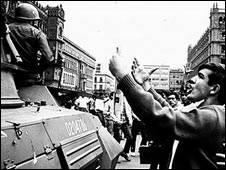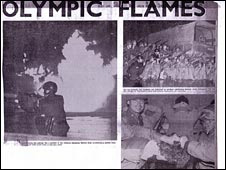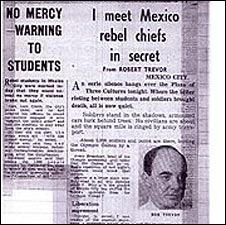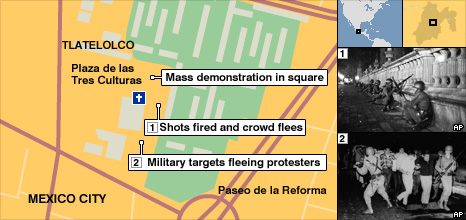
|  |  |  News Around the Republic of Mexico | October 2008 News Around the Republic of Mexico | October 2008  
'The Most Terrifying Night of My Life'
 BBC News BBC News
go to original


| | Tensions had been simmering in Mexico ahead of the Olympic Games | 
| | The killings thrust Mexico into the international spotlight | 
| | Robert Trevor says re-reading his reports brings back powerful memories | | |
In October 1968, British journalist Robert Trevor was in Mexico City getting ready to cover the Olympic Games which were about to start.

But he ended up reporting on one of the bloodiest episodes in Mexican history, what he calls "the most terrifying night of my life".

Mr Trevor, then aged 34, was the sports editor of the London Evening News and was in the Mexican capital to report on his third Olympics.

In the run-up to the Games, Mexico had been caught up in the wave of social and political unrest that had erupted in other parts of the world throughout 1968. But Mr Trevor says the people he first met were just excited about the sports events.

"The atmosphere was one of pleasure at having the Olympic Games. The Mexicans were proud of their Olympics. They wanted them to go off as well as possible," Mr Trevor told BBC Mundo.

He heard that a political demonstration was planned for the evening of 2 October in Tlatelolco Square, or Plaza de las Tres Culturas. He went along to see if there would be a story in it.

"There was a big crowd there, about 3,000," he says, most of them young students and union activists.

"To begin with it was very peaceful and quiet. Everyone was listening to the speeches calling for the resignation of President Diaz Ordaz and for the government to rule according to the Mexican constitution."

"There were calls for better housing, better education, better food."

But then shots were fired from nearby rooftops.

"Before people could grasp what was happening, helicopters arrived, helicopter gunships that started firing down on the crowd," he says.

An American journalist from the UPI news agency standing next to Mr Trevor suddenly found himself covered in other people's blood.

"When the helicopters opened fire and flares were dropped to light up the square, people were absolutely terrified," Mr Trevor recalls.

The crowd began darting down side-streets to try to escape.

"As we ran down the streets we were met by Mexican soldiers in full battle order - steel helmets, rifles - and backed by armoured cars.

"People were being shot at from the front, by the foot soldiers, and from behind by the helicopter gunships, so they were trapped. It was terrible, there was no escape."

Mr Trevor managed to run down a street that eventually took him back to Mexico City's main thoroughfare, Paseo de la Reforma.

"There it was unbelievable because the restaurants were full, people were coming out of cinemas, people were walking up and down the boulevard. Nobody knew what was happening 800m (2,600ft) away. It was unreal."


| Tlatelolco Timeline

• 2 Oct 1968: Soldiers spray bullets on demonstrators, number killed unclear. Figures vary between 30 and 300

• 1990s: After years of official silence, calls for investigations grow

• Feb 1998: Legislative commission blames Luis Echeverria, then interior minister and later president. He says the army acted on orders of President Gustavo Diaz Ordaz, who died in 1979

• 2002: Federal investigation ordered

• 2007: Mr Echeverria's trial on genocide charges suspended due to lack of evidence

• 2008: 40 years on, families of victims and disappeared still calling for justice, demanding to know who ordered the massacre and exactly how many died |

Mr Trevor headed to a hotel where the International Olympic Committee had its headquarters and met up with other foreign journalists.

Some of them said they had been escorted from the square by security forces before the shooting happened and held at gunpoint in nearby houses until it was all over, so they did not see anything.

Robert Trevor filed his report which was on the front page of the London Evening News the next day.

"I published the story of what I had seen and heard. I also reported the fact that the police commissioner in Mexico City, Luis Cueto, had held a press conference claiming that only 25 people had been killed, including seven policemen. I knew this wasn't true because I had seen more people than that being shot."

In fact, the number of victims has remained shrouded in mystery and controversy.

In the days afterwards, the government spoke of some 30 victims, human rights groups and foreign journalists have put the number of dead at around 300.

The names of many of the victims or what happened to their bodies remain unknown.

A week after the killings, the media's attention had switched to the opening ceremony of the Olympics.

"We were all there to cover the games, really," Mr Trevor says.

But Mr Trevor, who has not been back to Mexico since then, says his memories of that time are still powerful.

"It was the most terrifying night of my life, there's no question about that."

And he recalls meeting a woman who told him how she went to the police in the immediate aftermath of the shootings to try to get news of her missing son.

Officers told her to go away and not annoy them.

"She hadn't got a son and never had, they told her. There was no proof of his existence. That story I will remember all my life," says Mr Trevor.

To this day, no one has been held to account for the Tlatelolco killings. |

 |
|  |



